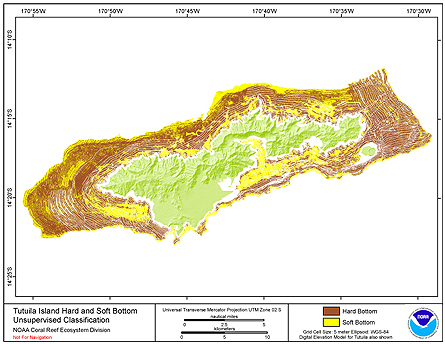Seafloor substrate (hard and soft bottom) maps at select islands and atolls in American Samoa, the Mariana Archipelago, and the Pacific Remote Island Areas
Access & Use Information
Downloads & Resources
-
tau_5m_hardsoft.zipZIP
Integrated Hard and Soft Bottom Seafloor Substrate Map of Tau Island,...
-
agu_4m_hardsoft.zipZIP
Integrated Hard and Soft Bottom Seafloor Substrate Map of Aguijan Island,...
-
rot_4m_hardsoft.zipZIP
Integrated Hard and Soft Bottom Seafloor Substrate Map of Rota Island,...
-
pag_5m_hardsoft.zipZIP
Integrated Hard and Soft Bottom Seafloor Substrate Map of Pagan Island,...
-
ofu_5m_hardsoft.zipZIP
Integrated Hard and Soft Bottom Seafloor Substrate Map of Ofu/Olosega...
-
tin_5m_hardsoft.zipZIP
Integrated Hard and Soft Bottom Seafloor Substrate Map of Tinian Island,...
-
tut_5m_hardsoft.zipZIP
Integrated Hard and Soft Bottom Seafloor Substrate Map of Tutuila Island,...
-
gua_5m_hardsoft.zipZIP
Integrated Hard and Soft Bottom Seafloor Substrate Map of Guam Island,...
-
sai_5m_hardsoft.zipZIP
Integrated Hard and Soft Bottom Seafloor Substrate Map of Saipan Island,...
-
ana_4m_hardsoft.zipZIP
Hard and Soft Bottom Seafloor Substrate Map of Anatahan Island, Mariana...
-
mau_4m_hardsoft.zipZIP
Integrated Hard and Soft Bottom Seafloor Substrate Map of Maug Island,...
-
kin_2m_hardsoft.zipZIP
Newly developed Hard and Soft Bottom Seafloor Substrate Map of Kingman Reef,...
-
pal_hardsoft.zipZIP
Integrated Hard and Soft Bottom Seafloor Substrate Map of Palmyra Atoll,...
-
ros_5m_hardsoft.zipZIP
Integrated Hard and Soft Bottom Seafloor Substrate Map of Rose Atoll,...
-
how_2m_hardsoft.zipZIP
Newly developed Hard and Soft Bottom Seafloor Substrate Map of Howland...
-
jar_2m_hardsoft.zipZIP
Newly developed Hard and Soft Bottom Seafloor Substrate Map of Jarvis Island,...
-
joh_2m_hardsoft.zipZIP
Newly developed Hard and Soft Bottom Seafloor Substrate Map of Johnston...
-
Full Metadata Record
View the complete metadata record on InPort for more information about this...
-
Pacific Islands Fisheries Science Center Website
Pacific Island Fisheries Science Center homepage
-
Pacific Islands Benthic Habitat Mapping Center...
NOAA ESD source data are accessible through this website.
-
NOAA Fisheries, Pacific Islands Region,...
This web page describes the corals listed as threatened under the Endangered...
-
GCMD Keyword Forum Page
Global Change Master Directory (GCMD). 2025. GCMD Keywords, Version 22....
-
NOAA Data Management Plan (DMP)PDF
NOAA Data Management Plan for this record on InPort.
Dates
| Metadata Date | December 3, 2025 |
|---|---|
| Metadata Created Date | October 19, 2024 |
| Metadata Updated Date | December 20, 2025 |
| Reference Date(s) | 2016-08 (creation), 2018-04 (revision), 2018 (publication) |
| Frequency Of Update | notPlanned |
Metadata Source
- ISO-19139 ISO-19139 Metadata
Harvested from NMFS PIFSC
Graphic Preview

Additional Metadata
| Resource Type | Dataset |
|---|---|
| Metadata Date | December 3, 2025 |
| Metadata Created Date | October 19, 2024 |
| Metadata Updated Date | December 20, 2025 |
| Reference Date(s) | 2016-08 (creation), 2018-04 (revision), 2018 (publication) |
| Responsible Party | Pacific Islands Regional Office (Point of Contact); (Custodian) |
| Contact Email | |
| Guid | gov.noaa.nmfs.inport:34310 |
| Access Constraints | Cite As: Pacific Islands Fisheries Science Center, [Date of Access]: Seafloor substrate (hard and soft bottom) maps at select islands and atolls in American Samoa, the Mariana Archipelago, and the Pacific Remote Island Areas [Data Date Range], https://www.fisheries.noaa.gov/inport/item/34310., Access Constraints: None, Use Constraints: These data are not to be used for navigation purposes. Please cite NOAA Fisheries Ecosystem Sciences Division (ESD) when using the data: Ecosystem Sciences Division, Pacific Islands Fisheries Science Center, 2018: Seafloor substrate (hard and soft bottom) maps at select islands and atolls in American Samoa, the Mariana Archipelago, and the Pacific Remote Island Areas, https://www.fisheries.noaa.gov/inport/item/34310., Distribution Liability: While every effort has been made to ensure that these data are accurate and reliable within the limits of the current state of the art, NOAA cannot assume liability for any damages caused by errors or omissions in the data, nor as a result of the failure of the data to function on a particular system. NOAA makes no warranty, expressed or implied, nor does the fact of distribution constitute such a warranty. |
| Bbox East Long | -168.115 |
| Bbox North Lat | -14.1 |
| Bbox South Lat | -14.57 |
| Bbox West Long | -170.92 |
| Coupled Resource | |
| Frequency Of Update | notPlanned |
| Graphic Preview Description | An example hard- and soft-bottom substrate map of Tutuila (prepared using a different methodology compared with the substrate maps prepared for the project described here). |
| Graphic Preview File | https://www.soest.hawaii.edu/pibhmc/amsamoa_images/TUT_unspv_hardvsoft_5m_445.jpg |
| Graphic Preview Type | JPG |
| Harvest Object Id | 76607275-e23f-4457-838f-af02392a0dac |
| Harvest Source Id | c0beac72-5f43-4455-8c33-1b345fbc2dfe |
| Harvest Source Title | NMFS PIFSC |
| Licence | NOAA provides no warranty, nor accepts any liability occurring from any incomplete, incorrect, or misleading data, or from any incorrect, incomplete, or misleading use of the data. It is the responsibility of the user to determine whether or not the data is suitable for the intended purpose. |
| Lineage | The steps in this analysis included: 1) re-categorizing all data to simple hard/soft substrates, 2) integrating all data following data prioritization rules established by an accuracy assessment, 3) filling gaps in data using interpolation, and 4) extracting the data to known depth ranges for the coral species in question. Biogeography Program shallow-water benthic habitat maps and ESD backscatter-derived hard-soft substrate maps were unavailable for several locations in the Pacific Remote Island Areas. Satellite images were processed for these places using the method described in Mumby and Edwards (2000) and then unsupervised classification was applied to derive hard and soft substrates for these places. |
| Metadata Language | eng |
| Metadata Type | geospatial |
| Old Spatial | {"type": "Polygon", "coordinates": [[[-170.92, -14.57], [-168.115, -14.57], [-168.115, -14.1], [-170.92, -14.1], [-170.92, -14.57]]]} |
| Progress | completed |
| Spatial Data Service Type | |
| Spatial Reference System | |
| Spatial Harvester | True |
| Temporal Extent Begin | 2003 |
| Temporal Extent End | 2010 |
Didn't find what you're looking for? Suggest a dataset here.

